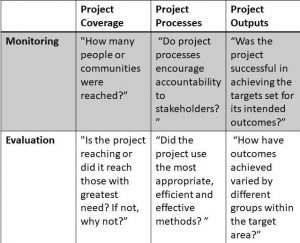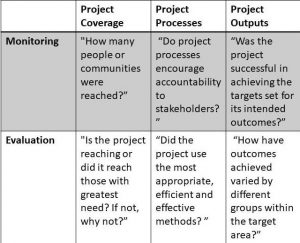How Can Monitoring and Evaluation Improve Accountability and Learning? To understand monitoring, evaluation, accountability, and learning (MEAL), let us explore the four components:
- Monitoring – It is the continuous and systematic collection, analysis, and reporting of data about project progress.
- Evaluation – The user-focused, systematic assessment of the progress, value, merit, or quality of an ongoing or completed project’s design, implementation, and results.
- Accountability – The commitment to respond to and balance the needs of all project stakeholders, including project participants, donors, partners and the organization itself, in the activities of the project.
- Learning – The culture and the set of processes and resources that enable intentional reflection for smarter decision-making.
How Can Monitoring and Evaluation Improve Accountability and Learning? These four components are both independent and interrelated. Each piece depends on and is informed by the other pieces. Some of the ways the components are connected include
- Monitoring provides information that helps identify what evaluation teams should explore and provides data that supports evaluations.
- Monitoring promotes accountability by demonstrating progress to donors, project partners, and project communities.
- Monitoring promotes learning by providing information that helps teams make evidence-informed decisions to improve projects during implementation.
- Evaluation promotes learning and accountability; it identifies opportunities for mid-course adjustments, and it informs future investments.
A MEAL system is only effective when project teams use monitoring and evaluation data to promote accountability and learning. Specifically, teams can use these data to demonstrate and improve the effectiveness, efficiency, outcomes, and impact of their project.
Difference Between Monitoring and Evaluation
Monitoring and evaluation are usually mentioned and thought to be the same, but they are not. Here are two ways in which they differ:
- The questions asked in monitoring are very different than the questions asked in evaluation.
For example, consider the fact that most projects are interested in measuring their progress and accomplishments in the areas of project coverage, project processes, and project results (including project outputs, outcomes, and impact). These three areas can be explored via monitoring and/or evaluation activities that ask different questions, as shown below.

- Monitoring and evaluation differ in terms of purpose, frequency, responsibility, and use of data. These differences are presented below.

How Do You Bring Accountability and Learning To Projects?
- You bring accountability to projects by promoting the characteristics listed below:
O Transparency – Teams promote transparency by sharing monitoring and evaluation information and results with communities, partners, donors, and other stakeholders.
O Alignment with standards – Teams promote alignment with standards by demonstrating that project work has been conducted in compliance with agreed donor requirements and MEAL best practices.
O Responsiveness – Teams promote responsiveness by establishing channels through which stakeholders can voice feedback, ideas, suggestions, and complaints. This involves a commitment to provide an appropriate response regarding how stakeholder input is informing project decisions.
O Participation – Teams promote participation by encouraging varying degrees of contributions from different types of stakeholders in initiating, defining the parameters for, and conducting MEAL.
Accountable projects are more relevant, and they are more likely to be supported by stakeholders. In addition, they ultimately will have a greater impact and sustainability. A commitment to accountability requires that project teams take proactive and reactive steps to address the needs of key stakeholders while delivering project results.
- Including learning in projects requires engaging stakeholders in thoughtful discussion of what has worked and what hasn’t worked in project efforts to achieve the stated objectives. These conversations should draw on monitoring data, evaluation data, and other appropriate evidence to inform any conclusions or decisions that emerge. You embrace learning through the approaches listed below:
O Incentivizing learning – Teams incentivize learning by framing all project work as a learning opportunity. They encourage, model, and reward learning.
O Encouraging a spirit of curiosity – Teams encourage a spirit of curiosity by establishing a workplace that supports asking questions, being curious, and challenging assumptions in the spirit of learning.
O Embedding learning processes – Teams embed learning processes by including concrete learning elements. For example, they use checklists to prompt learning, and they include learning questions in meeting agendas.
O Promoting adaptive management – Teams promote adaptive management by analyzing monitoring and evaluation data promptly and frequently. They actively seek to understand project data. They use evidence to inform decisions and to adjust project design, planning, and implementation.
O Sharing information – Teams share information by using project learning to inform organizational and sectoral best practices.
MEAL Phases
MEAL is present and ongoing during every stage of a project: from the earliest steps of project design to the last activities of project closure. How Can Monitoring and Evaluation Improve Accountability and Learning? Project MEAL activities are organized into five phases, namely:
1. Designing Logic Models
In the designing phase, the project team develops logic models: the theory of change, the results framework, and the logical framework. Logic models show how the change will happen. They explain the change a project is seeking to achieve, the steps by which change will occur, and how the change will be measured.
2. Planning MEAL
In the Planning phase, the team develops more detailed and comprehensive plans for MEAL. Many planning tools are available. The team chooses the best one for the size and complexity of the project.
And for every project, they integrate and align MEAL activities, budget, and calendars with the larger project plan.
3. Collecting MEAL Data
In the collecting phase, the project team develops and uses tools to collect high-quality, timely data that measure progress and facilitate decision-making and learning.
4. Analyzing MEAL Data
In the analyzing phase, the project team analyzes MEAL data. They conduct data analysis during and after project implementation, according to the analysis plans established during the MEAL planning phase.
5. Using MEAL Data
In the Using phase, the project team uses MEAL data to inform management decisions, inform communications, and promote accountability.
Based on their learning, project teams should look for opportunities to update the project MEAL system, so it can improve over time and adapt to any changes in the project context.
Cross-Cutting Themes of MEAL
There are two cross-cutting themes to always keep in mind during the design, planning, and implementation of a MEAL system. These cross-cutting themes are participation and critical thinking. Teams should integrate these themes into all their MEAL activities.
Encouraging participation and critical thinking is investing in sustainable impact. It is one way of addressing some of the most challenging issues that arise when conducting MEAL activities, including gender inequalities, discriminatory practices, and unjust power relationships.
-
Participation
The first cross-cutting theme of MEAL is participation. Teams promote participation by soliciting contributions from project stakeholders (including project participants, donors, partners, and others) when initiating MEAL, when defining the parameters for MEAL, and while conducting MEAL. That is, at every phase of the MEAL process, team members should ask, “To what extent are the project’s stakeholders participating in MEAL activities?”
Participation by stakeholders comes in many forms. This is because there are many different kinds of stakeholders and different levels of contribution too. A stakeholder could be a project partner organization or a project participant. A stakeholder could also be a local government office or the project’s donors. Relevant stakeholders vary depending on the local setting.
A stakeholder is someone who has an interest in and/or an influence on the project. Teams should encourage participation by stakeholders at every phase of the MEAL process. Levels of participation range from very limited provision of advice or feedback to extensive, active involvement in the design and implementation of data collection methods and tools.
Advantages of participation
By focusing on participation by stakeholders, the project team can:
O Ensure that MEAL findings are relevant to the local context
O Promote a sense of ownership among stakeholders for project results
O Increase local level capacity in MEAL
O Contribute to improved communication and collaboration among program actors who are working at different levels of program implementation
O Strengthen accountability to all stakeholders
O Promote a more efficient allocation of resources
O Increases the likelihood of a project’s sustainability.
Good MEAL processes incorporate a variety of stakeholder perspectives from beginning to end.
-
Critical Thinking
The second cross-cutting theme of MEAL is critical thinking. It is a process of thinking that is clear, rational, open to different opinions, and informed by evidence. Good MEAL processes require a consistent commitment to critical thinking from beginning to end.
What critical thinking looks like in practice
In practice, critical thinking requires that project teams apply a certain approach as they design, plan, and implement MEAL activities. This approach is characterized by:
O A willingness to identify the assumptions that shape our thinking and influence our actions
O A desire to test the extent to which the assumptions are correct and well-founded
O A capacity to ask thoughtful questions to pursue deeper understandings
O An openness to multiple, sometimes conflicting perspectives reflecting different expertise, experiences, and evidence
O A commitment to reflection and analysis to inform actions.
Pros of applying critical thinking
How Can Monitoring and Evaluation Improve Accountability and Learning? One of the many advantages of applying critical thinking to MEAL activities is that it helps reduce the risk of not properly understanding the context of a project setting. It reduces the risk of misinterpreting the evidence generated by the MEAL system. No system will collect, analyze, interpret, and communicate data perfectly. However, by adopting the critical thinking approach described above, teams can act deliberately to reduce the risk of making invalid assumptions about the expected or actual results of project interventions.
Ethical Standards in MEAL
When MEAL systems are designed and implemented correctly, projects have the capacity to track progress, make informed decisions, adapt to improve performance and increase project impact.
When MEAL systems are not designed and implemented correctly, problems occur. Poorly designed and implemented MEAL systems can have a number of adverse effects, including (but not limited to):
O Wasting project resources and participants’ time by asking the wrong questions or collecting data that won’t be used
O Compromising the security and social welfare of participants by failing to respect standards of confidentiality and anonymity
O Hurting the credibility of the project by failing to be transparent about MEAL activities
O Reducing the project’s impact by failing to collect and analyze the MEAL data needed to improve the project operations and strategy
Common Ethical Principles
Many organizations require that certain ethical principles are followed in order to guide the design and implementation of MEAL and avoid problems. Ethical principles vary by organization, but some are commonly used. Commonly used principles include Representation, Informed Consent, Privacy and Confidentiality, Participant Safety, Data Minimisation, and Responsible Data Usage.
Aligning MEAL with Project Requirements
For MEAL to be successful, the MEAL planning process must ensure that MEAL is included in the larger project implementation plan. Most importantly, MEAL needs to be included in three important elements of the larger project plan: Schedule, Budget, and Staffing.
Summary
How Can Monitoring and Evaluation Improve Accountability and Learning? Every project is different, and each project’s MEAL systems will reflect its uniqueness. MEAL systems will reflect the organization’s policies and culture in support of MEAL, the project context, the project value and duration, donor MEAL requirements, stakeholder information needs, and the project’s complexity and associated risks, among other things.
No matter what is happening in the larger project context, project teams should always be hard at work, designing, planning, and implementing MEAL activities. MEAL is everyone’s responsibility, and it is critical to integrate MEAL into the wider project implementation plan. Including MEAL in staffing, budgets, and calendars is an important step to ensuring support for quality MEAL.

